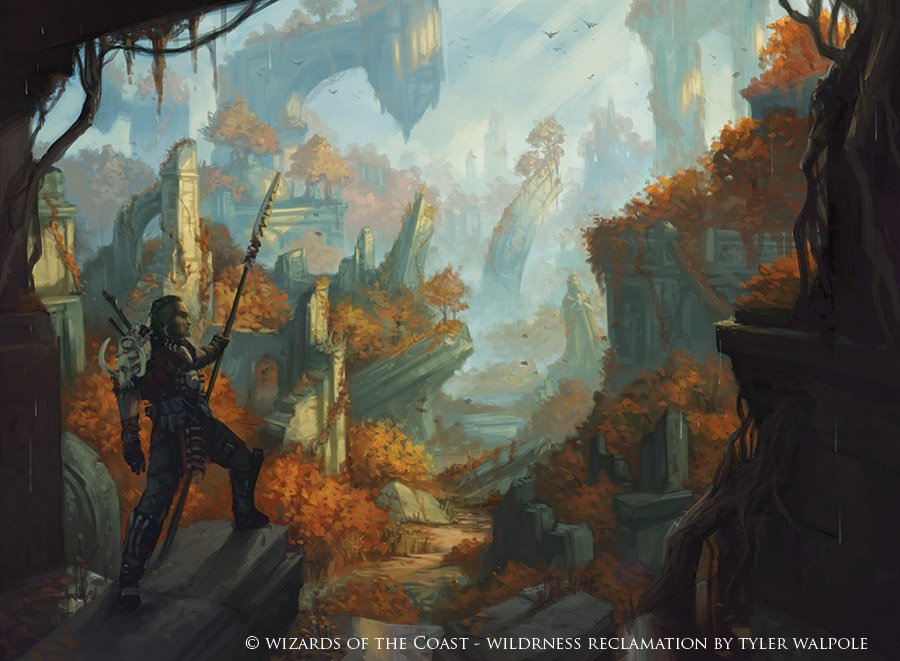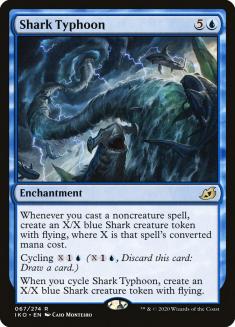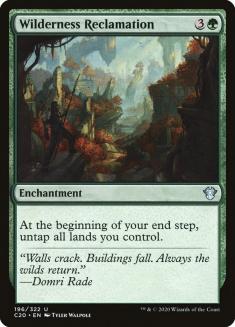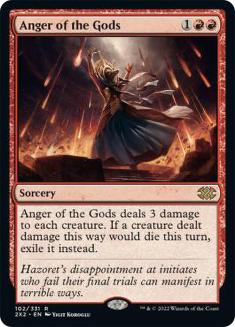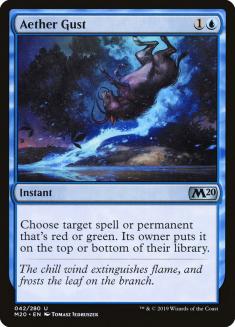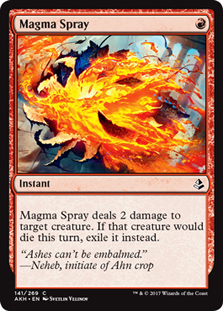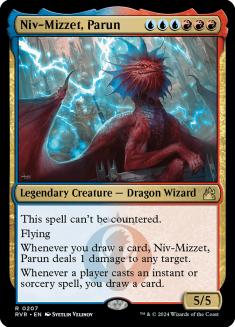With most of competitive Magic happening on Magic Arena, it’s easy to forget that some really great formats exist and can be played for high stakes on Magic Online. While I personally think the Magic Arena client is superior for viewership, you can’t really have a substitute for playing Modern, or Legacy, or even Pioneer! Well, at some point Historic and Pioneer should meld into one format but we’re still pretty far off from it.
When Pioneer was first announced, it was one of the most fun experiences of my Magic-playing career. Trying to break it every single week resulted in a lot of experimentation, variable gameplay, and deep understanding of the good and bad types of interaction in the format. While Uro, Titan of Nature’s Wrath pushes the envelope a bit, the current state of Pioneer is pretty good. There are roughly eight viable and great decks to choose from, including one of my old Standard favorites:
Creatures (3)
Lands (23)
Spells (34)
- 1 Forest
- 1 Mountain
- 1 Island
- 3 Anger of the Gods
- 3 Censor
- 1 Sinister Sabotage
- 1 Chemister's Insight
- 4 Expansion
- 4 Growth Spiral
- 4 Wilderness Reclamation
- 4 Mystical Dispute
- 3 Shark Typhoon
- 2 Spikefield Hazard
- 2 Jwari Disruption
Sideboard

The play patterns of this deck should be familiar to anyone who played the archetype while it was in Core Set 2021 Standard. Instant-speed interaction and ramp allows you to cast Wilderness Reclamation. After you have so much mana at your disposal, you can use it to win basically however you like. The most common play pattern is activating Castle Vantress until you find Expansion/Explosion to finish the game, but so many of your spells cycle or push you toward your ultimate endgame.
When a writer talks about velocity in Magic, what they’re trying to convey is how some spells allow you to keep casting spells, gaining micro advantages over time. While you’re spinning your wheels a bit on some turns, the goal is finding Wilderness Reclamation into Expansion/Explosion. Every card helps churn the machine, finding small points to interact and slow your opponent down until you reach your goal.
The big upgrades that this deck has gotten recently allow for more variation in gameplay. Spells acting as lands, as well as win conditions that can cycle, are both exceptional in a deck that wants to play Wilderness Reclamation. I always thought Censor was an all-time banger in this type of deck, and the addition of both Jwari Disruption and Spikefield Hazard are welcome. Dead removal spells are a thing of the past. In archetypes like this, having dead cards of any kind is a no-go.
One of the weirder holdovers from the Standard version of Temur Reclamation to Pioneer was the inclusion of Mystical Dispute in the maindeck. From what I’ve gathered, Mystical Dispute is more than fine to pay the full price forT. While it’s not exactly ideal for three mana, it does a thing and it’s not so bad at it. The money ball is when Mystical Dispute becomes Dispel.
Resolving a Wilderness Reclamation against a deck with counterspells is not easy. In the past, whenever someone wanted to resolve a four-mana card at sorcery speed, they would often sideboard Dispel to protect them on their big turns. Mystical Dispute does that most of the time, but also functions like a bad Cancel during all other points in the game.
The joke is that this deck exports more mana than just about any deck I’ve played over the last year outside of dedicated Lotus Field Combo, so having a spell cost three mana and be mediocre in a lot of spots is just fine so long as you have access to the “good” part of Mystical Dispute. The absolute blowouts for one mana are unreal. Imagine playing against a card like Teferi, Time Raveler and just putting your opponent in the dumpster out back for a single mana. The play pattern of Growth Spiral into Mystical Dispute on the second turn feels like you’re getting away with something.
It’s rare that a sideboard card goes into the maindeck, but Mystical Dispute is not a design we see very often. Cards that are weak but still playable against a significant portion of the field that also become supercharged in some spots are virtually non-existent outside of Mystical Dispute, so there’s nothing really to compare it to. I sincerely believe Mystical Dispute is one of the reasons why Temur Reclamation can shine in such a hostile, powerful format.
If they won’t ban it, I should probably just bite the bullet and play it. I’ve hooped and hollered about Uro for a while now, but I don’t think it’s going anywhere. With that said, I doubt I need to describe to you the impact it can have in this deck or against various opponents. Let’s just discuss how it interacts in your deck and what it adds to your overarching strategy.
Most decks are using Uro as a finisher that also helps you get ahead on mana generation. Temur Reclamation essentially does the opposite. Putting Uro onto the battlefield via escape isn’t a rare occurrence, but it isn’t the top priority. There won’t be many games where Uro singlehandedly steals the show, but it will provide you with a bit of ramp, a nice life buffer, and a few drained resources from the opponent.
When someone is trying to break you down via Thoughtseize, a card like Uro is invaluable. It’s basically a Chemister’s Insight that sits on the battlefield as one of the most intimidating attackers of all time. Allowing Uro to attack is like conceding the game. Losing after attacking with Uro is so rare that the only time I can remember it happening is when its a desperation attack looking for a sweeper like Anger of the Gods.
It won’t always be possible to resolve Explosion for lethal against a deck playing a bunch of counterspells, so having a threat that can win the game in just a few attacks that’s also hard to remove via conventional means is valuable. The fact that it works so nicely with the rest of your scheme is not a coincidence. Uro embodies everything a Simic deck is trying to do while rewarding you directly for playing a splash color that heavily interacts.
Another “new-ish” addition to the archetype, Shark Typhoon is a card that really boosted the Standard version quite a bit. Generating a ton of mana with Wilderness Reclamation isn’t difficult and finding various ways to spend that mana profitably is the primary goal. Shark Typhoon is a fantastic card in Temur Reclamation because of how flexible it is while getting absolutely juiced when you have access to a boatload of mana.
Creating a threat at instant-speed is something I did quite early on in Wilderness Reclamation, though my threat of choice was Torrential Gearhulk. I used it alongside removal, card draw, ramp effects, and even Fog. The hangup with Torrential Gearhulk was two-fold. First and foremost, Torrential Gearhulk is expensive. Even if we’re ramping, the games where we don’t hit six mana aren’t exactly uncommon against an aggressive deck. Missing that land drop is often what gets us killed. Shark Typhoon doesn’t have this problem. Torrential Gearhulk is also a card that relies on the graveyard, which is a bit awkward when so many people will overreact to Uro. Lastly, Shark Typhoon scales as the game progresses. Torrential Gearhulk doesn’t really work with Expansion/Explosion or any of your gamebreaking spells. It’s just a big Snapcaster Mage. That in and of itself isn’t a bad thing, but it’s not reliable at winning the game.
Given enough mana, Shark Typhoon can eat your opponent in one bite, and Wilderness Reclamation can make a lot of mana.
The star of the show, Wilderness Reclamation is the deck’s engine. Generating a ton of mana isn’t exactly easy, so any card that can do it singlehandedly will usually have some decks built around it. Wilderness Reclamation has the caveat that you need to be able to use the mana at instant-speed, but time has taught us how easy that can be achieved. The addition of Shark Typhoon to the archetype only made it that much easier.
The biggest interaction in the deck, and one I brought up earlier, is the ease in which this deck can assemble Castle Vantress and Wilderness Reclamation. Because Castle Vantress is a land, there is no real penalty in deckbuilding other than putting an emphasis on Islands. The functionality is similar to Search for Azcanta except you don’t have to play a weak enchantment on the second turn that takes three turns or so to transform into something useful.
Explosion is the natural pairing with Wilderness Reclamation for closing the game, but the times where you cast an Explosion for X=2-6 are pretty frequent. Using the first Explosion or two for resource generation is common, as the first or second one often finds the third or fourth. They chain together quite often and very nicely. There aren’t a lot of instant-speed Fireball effects in Pioneer, so our options for closing the game with Wilderness Reclamation in one fell swoop are somewhat limited. Because of the pinch created by having Explosion are your top-end, your vulnerability often comes at the hands of counterspells. To fight this, many Wilderness Reclamation pilots lean Sultai so they don’t have to play Explosion. The addition of black gives you a bit stronger interaction, but losing out on the diverse and powerful Expansion/Explosion really takes the wind out of my sails.
I’ve not talked much about this one in Pioneer, but mostly because there was rarely a reason to play it over Deafening Clarion. Since we’re not playing white and the sweepers available in red aren’t exactly overwhelmingly powerful, Anger of the Gods is one of the few options we actually have to clear early creature rushes. The fact that it exiles the creatures is actually huge in Pioneer because two of the more popular aggressive decks play either Lurrus of the Dream-Den or Scrapheap Scrounger.
Anger of the Gods costing double red is often the limiting factor, but Ketria Triome has alleviated a lot of the pressure on the manabase. Because of our intense mana generation, the expensive cost of cycling it isn’t exactly a huge downside. We also don’t play many one-mana spells so there’s no need for it to enter the battlefield untapped on the first turn. But enough about Ketria Triome. What does Anger of the Gods actually do in our deck?
It helps us survive. Aggressive decks have often been the bane of Temur Reclamation across multiple formats. No amount of spot removal can help you overcome a deck full of one-mana creatures because you’re spending more than one mana on average to deal with them. However, a three-mana sweeper effect that exiles all of those creatures is exactly what you need to survive in such a matchup. It might rot in your hand against combo and control, but there are few other cards in Pioneer that aggressive decks fear more than Anger of the Gods.
A Closer Look at the Sideboard
Fry is a double-sided weapon here, helping defeat Spirits (one of your tougher matchups), but also giving you outs against some of the worst cards a Temur Reclamation pilot can see. Teferi, Time Raveler is a target we need to be able to kill, even if it costs one more mana than Rending Volley.
There are some weird matchups where Fry has some legs, but it’s mostly for Spirits and Teferi.
A card that’s very close to seeing maindeck play in Pioneer, Aether Gust is one of the most disgusting sideboard cards ever printed. I loathe playing with and against this card because of the weird types of interactions it allows for. The only crime is playing some nice red or green spells and here comes an opponent that can destroy or counter anything for just two mana? Utter nonsense. But like I said earlier, we’re just going to take things in stride and play the best cards while we can.
Like Anger of the Gods, exiling creatures instead of sending them to the graveyard can have some value. Some matchups also just require overloading on removal, so having that removal also exile is virtually free. While something like Shock might be more versatile, the impact Magma Spray has in a matchup featuring Scrapheap Scrounger is ahead by leaps and bounds.
One of the classic “good sideboard cards” for blue, Negate can come in against a lot of different opponents. It’s a pretty easy tradeout for Anger of the Gods against any opponent that doesn’t have creatures. Negate is also a card I’ve seen start to pick up popularity in the maindeck of Temur Reclamation.
Niv-Mizzet, Parun is an uncounterable threat that often ends the game on the turn you get to untap with it. Wilderness Reclamation often makes that a reality on the turn you cast Niv-Mizzet, Parun because you get to untap and cast a bunch of spells before passing the turn. If your opponent has creatures on the battlefield, you get to mow them down while drawing a bunch of cards. If your opponent has no creatures, you get to deal them a ton of damage and draw a bunch of cards just for casting some interaction or whatever else.
Pioneering Temur Reclamation Once Again
Temur Reclamation is a great deck in a cool format. Pioneer as an idea was awesome, but I feel like it’s slowly getting forgotten. Part of that is because live play is impossible these days and Pioneer isn’t a format on Magic Arena, so fewer eyes are on it. Like Modern, there’s an audience for it but the current player base is much smaller than it should be thanks to the pandemic.
If you were a fan of Pioneer before the pandemic, or are just thinking of giving it another try, Magic Online might be the place for you. While it isn’t as flashy or new as Magic Arena, it’s a great place to experience some of Magic’s greatest formats on a client that more closely resembles paper Magic than its successor. There’s a lot to love about Magic Arena, but there is no substitute for casting Brainstorm or using Nykthos, Shrine to Nyx to cast Ulamog, the Ceaseless Hunger.
Pioneer is still flush with playable archetypes, powerful cards that are currently unexplored, and untested brews that could have a shot. There’s a lot of potential still here if you’re looking for a fresh experience, and Temur Reclamation offers a familiar style to those looking to branch into a new space. If you’ve played Temur Reclamation in Standard, this iteration should be a piece of cake to pick up and pilot. Magic Online is running PTQ-equivalent tournaments featuring the Pioneer format on a regular basis, so you could also use this fun format to qualify for some of the marquee tournaments. I’ve had some fun playing Historic, but I can only win or lose on the back of Muxus, Goblin Grandee so many times before I start to try out a different experience.
Go play some Pioneer on Magic Online!

